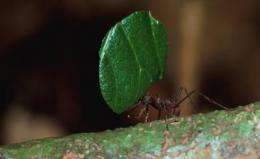Food security for leaf-cutting ants: Workers and their fungus garden reject endophyte invaders (w/Video)

New diseases directly affect human survival and food security, especially as population density climbs. Leaf-cutting ants, one of a few groups of social insects to cultivate crops, have harvested plant material to fertilize their underground fungal gardens for ~50 million years. New results from the Smithsonian show that both the ants and their fungal crop actively combat fungi coming into the nest inside leaves, thus ensuring the health of their mutualism.
"When you look at a healthy tropical plant, you think you're seeing just one organism, but each leaf can have dozens of fungal species growing inside, some of which may protect the plant by excluding pathogens," explains Sunshine Van Bael, post-doctoral fellow at the Smithsonian Tropical Research Institute. The fungi growing inside leaves without causing disease to the plant are called endophytes: endo-, inside, and -phyte, plant.
"We knew that leaf cutter ants practice phenomenal garden hygiene. But we wondered if the fungi in leaves might make them less attractive to ants, and thereby protect the plant from leaf cutter ant invasion. Also, since most leaves in nature have endophytic fungi, we wondered how the ants' leaf preparation process might affect the passage of endophytes into the nest."
Van Bael and colleagues used laboratory colonies of one leaf cutter ant species, Atta colombica, to test the ants' response to leaves from a tropical vine, Merremia umbellata, in which they had experimentally manipulated the densities of one fungal endophyte species, Glomerella cingulata, in order to present the ants with leaves containing either high or low levels of fungus. They also pitted 32 additional endophytic fungal strains against cultures of the garden cultivar in Petri plates to find out if they would restrict each others' growth.
Ants cut leaves that contained both high or low levels of fungi, but they took longer to cut leaves from the high endophyte treatment. Moreover, the leaf preparation process by the ants significantly lowered the amount of fungi in leaf pieces before they were placed into the fungal garden. The Petri plate experiment also showed that the garden fungus reduced the growth rate for 28 of the 32 endophytic fungal strains that were tested, with a stronger effect for more rapidly growing endophyte strains. This suggests that, apart from the hygiene practiced by the ants, the garden itself can compete with incoming microbes.
"Fungi in the leaves were not welcome in the leaf cutter ants' garden," concluded Van Bael.
Their work is published online in the Proceedings of the Royal Society B.
Source: Smithsonian Tropical Research Institute
















